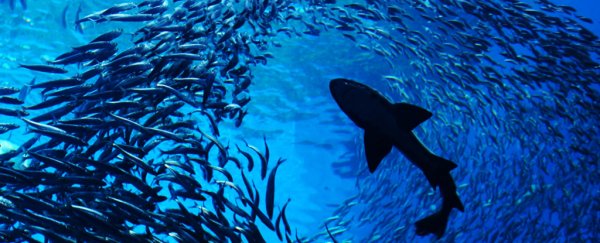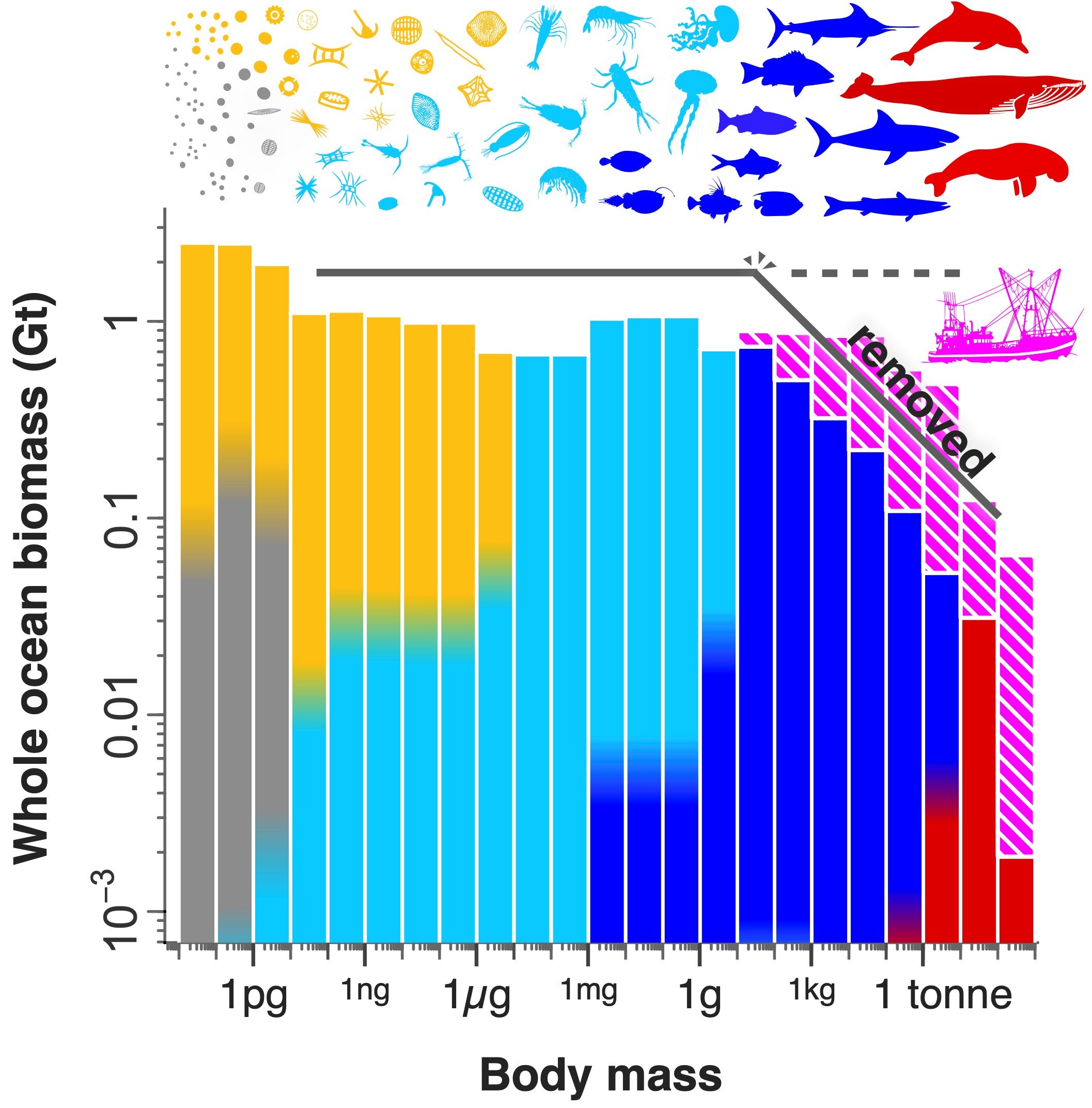
(Má Li Huang Mù/EyeEm/Getty Images)
TESSA KOUMOUNDOUROS
12 NOVEMBER 2021
Just as with planetary or molecular systems, mathematical laws can be found that accurately describe and allow for predictions in chaotically dynamic ecosystems too – at least, if we zoom out enough.
But as humans are now having such a destructive impact on the life we share our planet with, we're throwing even these once natural universalities into disarray.
"Humans have impacted the ocean in a more dramatic fashion than merely capturing fish," explained marine ecologist Ryan Heneghan from the Queensland University of Technology.
"It seems that we have broken the size spectrum – one of the largest power law distributions known in nature."
The power law can be used to describe many things in biology, from patterns of cascading neural activity to the foraging journeys of various species. It's when two quantities, whatever their initial starting point be, change in proportion relative to each other.
In the case of a particular type of power law, first described in a paper led by Raymond W. Sheldon in 1972 and now known as the 'Sheldon spectrum', the two quantities are the body size of an organism, scaled in proportion to its abundance. So, the larger they get, there tend to be consistently fewer individuals within a set species size group.
For example, while krill are 12 orders of magnitudes (about a billion) times smaller than tuna, they're also 12 orders of magnitudes more abundant than tuna. So hypothetically, all the tuna flesh in the world combined (tuna biomass) is roughly the same amount (to within the same order of magnitude at least) as all the krill biomass in the world.
Since it was first proposed in 1972, scientists had only tested for this natural scaling pattern within limited groups of species in aquatic environments, at relatively small scales. From marine plankton, to fish in freshwater this pattern held true – the biomass of larger less abundant species was roughly equivalent to the biomass of the smaller yet more abundant species.
Now, Max Planck Institute ecologist Ian Hatton and colleagues have looked to see if this law also reflects what's happening on a global scale.
"One of the biggest challenges to comparing organisms spanning bacteria to whales is the enormous differences in scale," says Hatton.
"The ratio of their masses is equivalent to that between a human being and the entire Earth. We estimated organisms at the small end of the scale from more than 200,000 water samples collected globally, but larger marine life required completely different methods."
Using historical data, the team confirmed the Sheldon spectrum fit this relationship globally for pre-industrial oceanic conditions (before 1850). Across 12 groups of sea life, including bacteria, algae, zooplankton, fish and mammals, over 33,000 grid points of the global ocean, roughly equal amounts of biomass occurred in each size category of organism.
"We were amazed to see that each order of magnitude size class contains approximately 1 gigaton of biomass globally," says McGill University geoscientist Eric Galbraith.
(Ian Hatton et al, Science Advances, 2021)
Hatton and team discussed possible explanations for this, including limitations set by factors such as predator-prey interactions, metabolism, growth rates, reproduction and mortality. Many of these factors also scale with an organism's size. But they're all speculation at this point.
"The fact that marine life is evenly distributed across sizes is remarkable," said Galbraith. "We don't understand why it would need to be this way – why couldn't there be much more small things than large things? Or an ideal size that lies in the middle? In that sense, the results highlight how much we don't understand about the ecosystem."
There were two exceptions to the rule however, at both extremes of the size scale examined. Bacteria were more abundant than the law predicted, and whales far less. Again, why is a complete mystery.
The researchers then compared these findings to the same analysis applied to present day samples and data. While the power law still mostly applied, there was a stark disruption to its pattern evident with larger organisms.
"Human impacts appear to have significantly truncated the upper one-third of the spectrum," the team wrote in their paper. "Humans have not merely replaced the ocean's top predators but have instead, through the cumulative impact of the past two centuries, fundamentally altered the flow of energy through the ecosystem."

Hatton and team discussed possible explanations for this, including limitations set by factors such as predator-prey interactions, metabolism, growth rates, reproduction and mortality. Many of these factors also scale with an organism's size. But they're all speculation at this point.
"The fact that marine life is evenly distributed across sizes is remarkable," said Galbraith. "We don't understand why it would need to be this way – why couldn't there be much more small things than large things? Or an ideal size that lies in the middle? In that sense, the results highlight how much we don't understand about the ecosystem."
There were two exceptions to the rule however, at both extremes of the size scale examined. Bacteria were more abundant than the law predicted, and whales far less. Again, why is a complete mystery.
The researchers then compared these findings to the same analysis applied to present day samples and data. While the power law still mostly applied, there was a stark disruption to its pattern evident with larger organisms.
"Human impacts appear to have significantly truncated the upper one-third of the spectrum," the team wrote in their paper. "Humans have not merely replaced the ocean's top predators but have instead, through the cumulative impact of the past two centuries, fundamentally altered the flow of energy through the ecosystem."
(Ian Hatton et al, Science Advances, 2021)
While fishes compose less than 3 percent of annual human food consumption, the team found we've reduced fish and marine mammal biomass by 60 percent since the 1800s. It's even worse for Earth's most giant living animals – historical hunting has left us with a 90 percent reduction of whales.
This really highlights the inefficiency of industrial fishing, Galbraith notes. Our current strategies are wasting magnitudes more biomass and the energy it holds, than we actually consume. Nor have we replaced the role that biomass once played, despite now being one of the largest vertebrate species by biomass.
Around 2.7 gigatonnes have been lost from the largest species groups in the oceans, whereas humans make up around 0.4 gigatonnes. Further work is needed to understand how this massive loss in biomass affects the oceans, the team wrote.
"The good news is that we can reverse the imbalance we've created, by reducing the number of active fishing vessels around the world," Galbraith says. "Reducing overfishing will also help make fisheries more profitable and sustainable – it's a potential win-win, if we can get our act together."
Their research was published in Science Advances.
While fishes compose less than 3 percent of annual human food consumption, the team found we've reduced fish and marine mammal biomass by 60 percent since the 1800s. It's even worse for Earth's most giant living animals – historical hunting has left us with a 90 percent reduction of whales.
This really highlights the inefficiency of industrial fishing, Galbraith notes. Our current strategies are wasting magnitudes more biomass and the energy it holds, than we actually consume. Nor have we replaced the role that biomass once played, despite now being one of the largest vertebrate species by biomass.
Around 2.7 gigatonnes have been lost from the largest species groups in the oceans, whereas humans make up around 0.4 gigatonnes. Further work is needed to understand how this massive loss in biomass affects the oceans, the team wrote.
"The good news is that we can reverse the imbalance we've created, by reducing the number of active fishing vessels around the world," Galbraith says. "Reducing overfishing will also help make fisheries more profitable and sustainable – it's a potential win-win, if we can get our act together."
Their research was published in Science Advances.
No comments:
Post a Comment